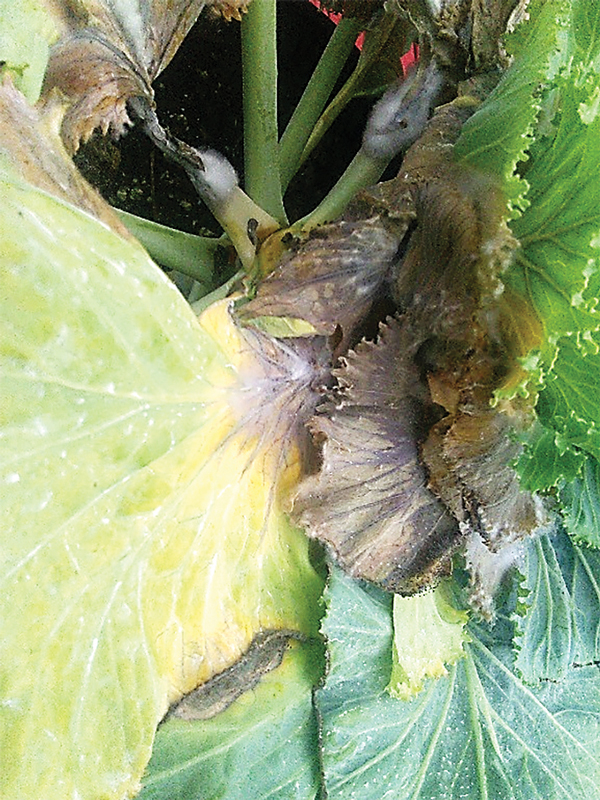12/1/2019
The Nightmare Before Christmas
Karen Stever

Fall crops have wrapped up across the country and growers are or will soon be saying goodbye and good riddance to the problems of last season. Hopefully, but maybe not—if the problem was a pest or disease with the potential to overwinter. No matter your production schedule, continuous or seasonal, don’t let your nightmare before Christmas come back to bite you at Easter or on Mother’s Day.
Thielaviopsis, Fusarium and Sclerotinia are some of the most insidious of plant diseases due to their ability to carry over from season to season, year to year. Each of these diseases has a mechanism that allows survival of the spores through even harsh environmental conditions. To prevent carryover in a production space, a rigorous de-infestation and disinfection of ALL surfaces in that space must be done—sidewalls, floors, benches, supports. Note pots are not on this list. If you’re fighting a persistent disease, which can become perennial if given the chance, pots should not be reused.
Pictured: Sclerotinia sclerotiorum on lettuce.
True sanitation is only accomplished by this two-step process of chemical cleaning to remove the major contaminating films and particles, followed by an application of a disinfecting sanitizer to eliminate the remaining organisms and their spores. Strong cleaners that may be highly acidic, such as Pace49’s Strip-it Pro and BioSafe Systems’ GreenClean Acid Cleaner, can be used in the greenhouse. For cleaning interior spaces such as coolers or packing rooms, Pace49’s Horti-Klor or BioSafe’s GreenClean Alkaline Cleaner are appropriate.
After cleaning and thoroughly rinsing, a sanitizer such as Kleengrow, a quaternary ammonium product, or an oxidizing sanitizer such as ZeroTol 2.0 or SaniDate 12.0, must be used in order to effectively eliminate disease spores. (Read and follow all label instructions and warnings.) These procedures can greatly reduce or eliminate the chance of carry-over.
It’s not just diseases that can survive in your production areas from season to season; insects that can over-winter include thrips, mites and mealybugs, all of which can survive the winter in your facility, heated or not. (Aphids, which normally bear live young, lay eggs to overwinter outdoors, yet this is generally not a greenhouse issue.)
Thrips nymph or larval stages mature until they drop down from the foliage to pupate in the potting soil or the soil on the floor. This is the overwintering stage. The pre-pupa and pupa stages of thrips don’t feed, so they’re immune to pesticides that work through ingestion. The pupal stages are also tolerant to most other pesticides used to control thrips.
If you’ve been fighting a major thrips infestation in a crop, plan to clean up immediately when the space empties. Pull all weeds, as they can be loaded with thrips eggs to adults. Clean up all plant debris and sweep, blow or wash the floors. If the populations have been high, consider the further step of drenching a soil-based floor to eliminate carry-over due to the pupae. Bioinsecticides Ancora or Botanigard WP, or the beneficial nematode Steinernema feltiae can be used for this purpose to break the life cycle.
Mites survive the winters in a resting state called diapause in the cracks and crevices of soil or concrete floors of unheated greenhouses. Once the mites have headed into hiding, there’s not much that can be done to control them. Knocking them down in the crops before they go into diapause is the best solution. Remove any weeds and plant debris and treat with an effective miticide or biological control during the crop cycle. Make sure the floors are weed-free when closing the house down.
During diapause, the two-spotted spider mites turn red. They emerge from their hiding places in spring to summer, sporting the red color. As temperatures warm up, thoroughly scout problem areas of the last season. If mites are detected, treat with a miticide or battle them with predatory mites Phytoseiulus persimilis, Neoseiulus fallacis or Amblyseius andersoni. (Note that P. persimilis is required for biological control once webbing is seen.)
N. fallacis and A. andersoni won’t penetrate webs, so they must be used early before that occurs. However, fallacis and andersoni are active at temperatures down into the 40s, making them amenable to late fall applications. Furthermore, fallacis can establish and overwinter in a cold greenhouse. If you’re new to biological control, consider all pesticides used in the last several months before ordering biocontrols.
Mealybugs are perhaps the most insidious survivalists of all due to their stealth and stamina. Mealybugs cling to surfaces, such as under the rim of pots, table supports or the lip of benches where they survive for months without food. This isn’t just a winter activity for these guys—it’s a way of life—and one of the reasons they’re so hard to control.
Battle mealybugs in your crops with spray applications of these relatively new products: Altus, Aria and Rycar or MOA 4A products like Flagship, Safari or Tristar. Use a horticultural oil such as Bioworks’ Suffoil-X to suffocate them with or without an added insect growth regulator such as Distance or Talus as a second mode of action for a soft chemical approach.
For a biological approach before the heat is turned down, use Ancora or Botanigard WP and mix with AzatinO for its insect growth regulator effect. Adding CapSil silicone surfactant to most spray mixes will improve application efficacy, particularly with mealybugs. Keep in mind all of these products will require contact to have any effect on over-wintering mealybugs. Scout previously infested areas frequently in the coming season for any re-appearance and treat immediately if seen.
Cleaning and sanitizing after each production cycle will save money, stress and lost sales in the coming season. It may not end all of your nightmares, but the process is very effective against many of the persistent pests you may face. GT
Karen Stever is a GGSPro Technical Support Representative for Griffin. She can be reached at ggsprotech@griffinmail.com.